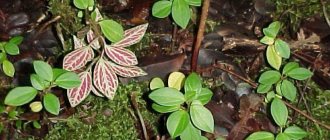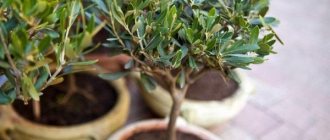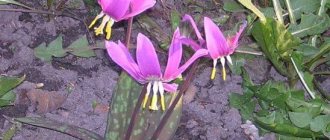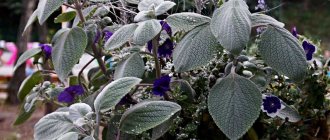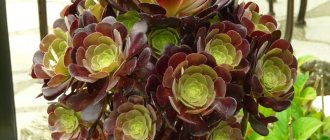Carnation is a beautiful decorative type of perennial that grows naturally in Asian countries. The flower was brought to Europe from China, Japan, and Turkey. Now this plant is grown all over the world. It is unpretentious, tolerates heat and cool weather, and produces not only attractive inflorescences, but also a pleasant aroma. Any type can be planted in a pot and grown as a houseplant. The rules for caring for indoor cloves at home are discussed in detail below.
Description of decorative carnations
This is a perennial herbaceous or subshrub plant. The maximum height of the stem is 70 cm, but at home, miniature species are more common, no more than 15-20 cm. There are varieties with standing and creeping stems. Forms many inflorescences with a characteristic spicy odor. One bud blooms on one peduncle, occasionally 2-3. Turkish cloves produce over a dozen small flowers on one stem.
The petals of most types of carnations are double, arranged 5 pieces on one inflorescence. After flowering ends, a fruit is formed in the form of a cylindrical box. It contains many small seeds. At the moment of ripening, the capsule bursts, the seeds fall into the soil and are partially dispersed by the wind.
Caring for garden carnations
Flowers in flower beds require some attention during growth. A few simple rules provide the most favorable conditions for cloves:
- weed removal;
- pinching a flower;
- frequent watering;
- loosening the soil;
- plant nutrition;
- garter.
Carnation does not like the proximity of weeds and grass; the flower must be freed from them. The abundance of weeds around the flower slows down or completely inhibits its growth. Weeding is an essential element of caring for this fragile beauty.
Caring for garden perennial carnations also involves pinching the top of the flower, which gives impetus to vigorous flowering. The plant begins to bush and produce side shoots. Pinching is carried out above the upper leaf node, with a stem height of 15 cm. How do you pinch a carnation? They do this with their fingers. After a month, the pinching is repeated.
We must not forget about moistening and nourishing the soil where perennial plants are planted. Street carnations require care, which involves moderate watering, after which the soil must be loosened.
Do not allow the soil near the carnation bushes to become waterlogged, as this can lead to rotting of the roots.
Organic and especially mineral fertilizers are added to the soil, this promotes good development of stems and vigorous flowering. It is important to feed the plant with complex fertilizers when the buds appear.
If the stems of the carnation grow very tall, the plant should be tied up. It must be in a vertical position, otherwise the stems will begin to break under the weight of the flowers. The stems are tied to the supports with twine or nylon thread. This must be done very carefully and not tightly.
When carnation flowers fade, they should be cut off immediately. This stimulates new flowering.
Garden carnations need to be prepared for winter. Frosts should not harm it. To do this, trim the wilted flower above the soil. Be sure to treat the soil around the plant with mulch. This will help the roots get a supply of nutrients. Some gardeners in regions with cold winters dig up flower bushes, replant them in boxes, containers or pots and bring them indoors for the winter. In this case, the carnation will safely overwinter.
Flowerbeds bloom all summer long if you remember these simple rules on how to grow perennial carnations.
Soil and pot
Cloves are unpretentious when it comes to substrate. Some gardeners advise using turf soil, peat and sand in a 2:1:1 ratio. Carnation is a flower that does not like high humidity, including soil. In this regard, you need to add a little more sand than in the pots of other plants.
If you don’t have time to mix the substrate yourself, it will be enough to pour ready-made universal soil into the container. It is sold in any flower shop. It may lack a number of fertilizers that cloves need, but these are added later.
How to grow a flower
This plant loves sunny areas.
There is no better place to grow carnations than flower beds, well lit by sunlight and protected from the winds. Perennial carnations in the garden grow well in light soil with neutral acidity, rich in humus and sand. The soil for it should allow water to pass through and not be waterlogged.
Plant the plant at a temperature of +15° C. Sow clove seeds in a substrate of humus, sand, turf soil in equal parts and lightly sprinkle. A very important question for a gardener is how to plant cloves correctly. The soil must be moist. To preserve heat and moisture, it is covered. After germination, there is no need to cover the crop.
When leaves appear, they are picked into separate containers and fertilized with mineral fertilizers. The grown carnation seedlings are planted in the flowerbed, maintaining a distance of 20 cm, and the soil is mulched. Planting garden carnations in compliance with agricultural techniques and further care helps to grow magnificent flowers.
Location and temperature
The culture is photophilous. It should be placed on a south, southeast or southwest window. This will extend daylight hours. The longer it is, the more nutrition the plant receives, which means it grows faster and forms flowers better. But you can’t overexpose the plant either: it can get burned. If you leave the pot on the south side, it should be shaded.
In winter, if the carnation was planted in the fall, the flower will need additional illumination using a phytolamp. This way the crop will receive the required amount of ultraviolet radiation. You can do without UV lamps, but in this case flowering may not take place. Without enough light, the bushes stretch out and become not so beautiful.
Humidity and watering
Air humidity is almost unimportant for cloves. It does not need to be additionally sprayed; for the reasons given above, this procedure is even contraindicated. Even in winter, when the central heating is turned on and the air becomes dry, additional moisture is not required.
May be interesting Sheflera: growing and caring at home Poisonous plant Oleander: planting and caring at home, Photo Cyperus: planting and caring at home, transplanting and propagation
As for high humidity, the plant does not tolerate it so well. As mentioned earlier, cloves are prone to fungus formation. You should not leave it in the bathroom or other wet areas. If you have subtropical flowers at home for which a humidifier is installed, the carnation should be removed away.
Watering is carried out as the soil dries. Instead of using a watering can at a strictly defined period, for example, once every 3 days, it is recommended to monitor the soil moisture. Flat wooden sticks, which are also used for ice cream, are well suited for this. The testing procedure is simple: the stick must be immersed in the substrate and left for 5 minutes. If, after removing it from the soil, there remains a wet mark on it, watering is not yet required.
Feeding
The clove itself practically does not need additional minerals, but if the owner needs lush flowering, it is worth taking care of applying fertilizers. After purchasing a plant in a store or transplanting it into a new pot, fertilizing should not be applied for a month. The flower must get used to the new conditions; fertilizing too early can negatively affect its immune system.
After the minerals have been added for the first time, you need to observe the condition of the cloves. The second time, fertilizing should be used at the beginning of the growing season, when buds begin to form. Further, throughout flowering, mineral fertilizers are needed every 2 weeks.
Fact!
Cloves need potassium the most. There is no need to buy special fertilizers; a universal store-bought composition is enough.
Transplanting indoor carnations
One of the key difficulties in caring for indoor carnations at home is that the plant is considered an annual. Carnations can continue to grow 2 or 3 years after planting, but most varieties produce almost no flowers in the second year.
If flowering begins, the buds appear not as large as the first time. Those who grow the flower for decorative purposes are not happy with this, so owners often uproot the bushes after the end of the growing season. In this case, a transplant is not required.
There is an alternative option - to cut carnations every year, and plant the old plant in wild conditions on a summer cottage or in a yard. More information about propagation by cuttings is described below.
Reproduction
Cloves are mainly grown from seeds. Even one plant produces enough of them that the entire windowsill can be covered with seedlings. The process of planting and growing from seeds:
- Prepare the soil by mixing peat with sand. Make holes with your finger and lightly moisten the soil.
- Distribute the seeds over the substrate. They need to be buried no more than 1 cm. Sprinkle the planting material with soil and water.
- Place the pot in a bright place. Moisten the soil as it dries.
- After 2 weeks, shoots will appear. When 2-3 true leaves are formed on each seedling, you can pick the seedlings, that is, plant them.
Photo with an example of picking indoor carnations when growing at home:
Reproduction does not end with planting. The final touch is needed - pinching. When the carnations already growing in separate pots have 5 pairs of leaves, the top of the plant needs to be trimmed. This will help the bush to form more lush.
Cuttings are also practiced. For carnations that have recently bloomed, the peduncles and all branches are cut off so that the plant rises no more than 6 cm above the pot. The cut young shoots are planted in moist soil and covered with plastic wrap. For 2 weeks, the cuttings should be kept in such a mini greenhouse, periodically removing the film for ventilation and watering.
Propagating carnations at home
The first and most common method is to grow cloves from seeds.
The sequence of actions is as follows:
- water the hole with water (instead of soaking the seeds);
- place the seeds in the hole to a depth of no more than 1 cm;
- sprinkle a thin layer of earth on top;
- moisten the soil with a spray bottle;
- cover the seedlings with polyethylene.
The polyethylene must be opened slightly at the edge several times a week to provide the seedlings with access to oxygen.
The first shoots appear within a couple of weeks. Before they appear, the soil needs to be moistened little by little. The sprouts should be transplanted into another container after a month; the distance between the sprouts should be at least 5 cm.
In addition to the seed planting method, cuttings can be used. To do this, you will need cuttings after flowering. It is necessary to root cuttings in a light substrate. The cutting is covered with polyethylene, a plastic glass or jar. It must be kept covered for a month, occasionally opening slightly for air exchange.
You can also root the cuttings in water. To do this, you need to place it in a container with a small amount of water and keep it there until roots appear. It is necessary to add water from time to time.
Pests, diseases and how to deal with them
Even with proper care of indoor carnations at home, you can notice that its leaves dry out (see photo). This could be a sign of disease or a pest attack.
Aphids and spider mites often feed on clove juices. Aphids gather in herds on the underside of leaves. It can be easily removed by washing the bush with soapy water. Spider mites are less noticeable; their presence can be determined by small cobwebs and the presence of a white coating on the back of the leaf. It will be more difficult to remove it with soapy water; it is better to immediately use an insecticide, for example, Aktara.
Note!
Much more dangerous are fungal diseases - gray and root rot.
If, with proper care at home, indoor carnations dry out, as in the photo, and brown and gray spots appear on the leaves, you have a fungus. Rot affects either the root system or the stems and leaves. Its other symptoms are swelling, watery plant tissue, a general drooping appearance of the flower, and an unpleasant odor.
Detected rotten areas must be urgently removed and the wounds treated with ash or iodine. To prevent the rot from going further, the soil must be thoroughly cleaned and pulled out, and the root system must be watered with a weak solution of potassium permanganate and then dried. Next, the flower is transplanted into new, dry soil. It should not be watered for several days.
Sometimes treatment does not help, and the cloves have to be thrown away. To prevent rot from destroying the plant, you need to follow the watering schedule, use proper drainage and calcinate or disinfect the soil with potassium permanganate before planting.
By following these rules, you will achieve lush and long-lasting flowering of carnations. She can delight with her buds for 2-3 months.
Possible problems in growing
Caring for carnations in a pot at home, although it requires little effort, can still cause problems. Over time, the plant may become lethargic or begin to turn yellow. Many problems arise with buds during the flowering and growing season.
- Drops buds and leaves
If there is a lack of nutrients in the soil, buds and leaves may drop. Lack of watering is also a significant reason for this behavior.
House carnation may turn pale, starting from the foliage, if powdery mildew has occurred. The leaves begin to turn white on the underside and can infect healthy “neighbors” on the windowsill.
- The tips of the leaves are drying out
The tips of the leaves can dry out if the neck of the stem has opened. The same effect can occur due to sunburn.
The leaf may fall from the lower tiers if the owner of the flower waters too frequently or water gets on the surface of the leaf plates.
Pests
Often homemade carnations are affected by spider mites. Aphid infestation occurs less frequently.
During this period, metamorphoses occur with the bush, which significantly worsen the appearance and can cause the death of the specimen.
It is advisable to move the infected plant away from the rest, then treat it with a soap solution.
Attention! It is important to ensure that the soap does not penetrate into the ground, to the roots. The soap solution can be left on the leaves for a couple of hours, then washed off.
Appearance of a healthy plant
Other problems
A decorative flower can die only if it is not properly cared for. A problem may arise if treatment is not carried out in the event of a disease or pest.
To decorate your home with original flowers, you should choose just such a culture. The plant is not whimsical, blooms for a long time and practically does not get sick. It is easy to propagate the flower; you can use the method of bush division, cuttings or sowing seeds.
Source




